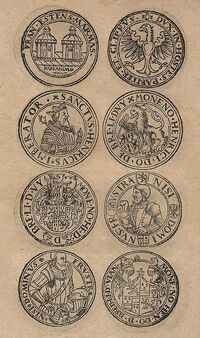| Duchy of Massa and Carrara Ducato di Massa e Carrara | ||||
|---|---|---|---|---|
| ||||
 Coat of arms | ||||
| Capital | ||||
| Languages | ||||
| Currency |
Bolognino, soldo | |||
| Establishment | ||||
| -Established |
February 22, 1473 | |||
| -Disestablished |
November 14, 1829 | |||
The Duchy of Massa and Carrara was a duchy existing from 1473 to 1829 that controlled the towns of Massa and Carrara. As of today, the area is now a part of unified Italy, but keeps its local identity as Massa-Carrara.
History[]

Maria Beatrice d'Este, the last ruler of the duchy.
The original core of the territory was officially created on February 22, 1473 with the purchase of the Signoria of Carrara by the Signoria of Massa by Iacopo Malaspina, who had obtained it by Count Antoniotto Filoremo of the Republic of Genoa.
During 1554, Alberico I Cybo-Malaspina decided to submit to the powerful, influential, and neighboring Roman Empire, which at the time was being ruled by Charles V. During 1568 Massa was elevated to a principality by Maximilian II.
During 1664, Massa had become a duchy while Carrara became a principality.
In 1796, Napoleon Bonaparte's troops invaded the Duchy of Massa and Carrara. The territory was annexed to the Cispadane Republic, and later, the Cisalpine Republic. During 1806, Napoleon gave the Duchy of Massa and Carrara to the Principality of Lucca and Piombino, which was ruled by Elisa Bonaparte, Napoleon's older sister.
After the re-establishment of the Duchy of Massa and Carrara, Maria Beatrice d'Este became the last duchess of the duchy. After her death in 1829, the territory was annexed to the Duchy of Modena and Reggio, lead by Francesco IV d'Este.
Economy[]

Various coins of the Duchy of Massa and Carrara.
The early economy of the duchy was rather stable, but during the War of the Spanish Succession, it began to enter a period of deep economic crisis. The Holy Roman Empire punished the Cybo-Malaspinas with heavy fines for given hospitaly to French troops on its territory. Alberico III and Alderamo Cybo-Malaspina found themselves forced to sell city goods. This crisis only recovered by a dynastic union between the Malaspina and d'Este families, which was achieved by the marriage of Maria Teresa and Ercole III d'Este during 1741.
During 1751, there was an attempt made to construct a port in the city of Carrara. It would have been functional for exporting the amounts of marble from the territory, but unfortunately, the cost tended to slit up over the years, and the construction had to be suspended. A second attempt to develop a port was made in 1830, but once again, the plan was never finished. Another project proposed, the Marble Railway, was also suspended due to lack of funds.
Currency[]
The Duchy of Massa and Carrara had changed currencies several times during its history. During the beginning of the duchy, it is assumed that it had issued its own currency or used the same currency as its predecessor.[1] After submitting to the Holy Roman Empire, it is most likely that they began using their currency, the thaler. Then, afterward, during its annexation into the Cispadane Republic it used the Bolognese lira, followed by the scudo, lira, soldo, and denaro of the Cisalpine Republic. When given to the Principality of Lucca and Piombino, the territory used the French franc as currency. Afterward, it is possible that the Duchy of Massa and Carrara had issued its own currency.
References[]
- ↑ Note: This is a user-made assumption.
External links[]
| Europe | |
|---|---|
| Countries | Albania • Andorra • Armenia* • Austria • Azerbaijan* • Belarus • Belgium • Bosnia and Herzegovina • Bulgaria • Croatia • Cyprus* • Czech Republic • Denmark • Estonia • Finland • France • Georgia* • Germany • Greece • Hungary • Iceland • Ireland • Italy • Kazakhstan* • Latvia • Liechtenstein • Lithuania • Luxembourg • Macedonia • Malta • Moldova • Monaco • Montenegro • Netherlands • Norway • Poland • Portugal • Romania • Russia* • San Marino • Serbia • Slovakia • Slovenia • Spain • Sweden • Switzerland • Turkey* • Ukraine • United Kingdom • Vatican City |
| De facto countries | Abkhazia* • Kosovo • Nagorno-Karabakh* • Northern Cyprus* • South Ossetia* • Transnistria |
| Dependencies | Åland • Faroe Islands • Gibraltar • Guernsey • Isle of Man • Jersey • Republika Srpska • Svalbard and Jan Mayen |
| Italian States | |
|---|---|
| Albera • Alessandria • Alghero • Ancona • Arquata • Ascoli • Asti • Avignon • Belgioioso • Belmonte • Benevello • Bergamo • Bologna • Bargo Val di Taro (Borgotaro) • Bozzolo • Brescello • Brescia • Brixen (Bressanone) • Cagliari • Camerino • Campi • Carmagnola • Casale • Casale Monferrato • Castiglione dei Gatti • Castiglione delle Stiviere • Cisalpine Republic • Cispadane Republic • Cisterna • Civitavecchia • Clitunno • Compiano • Correggio • Corsica, Kingdom of • Corsica, Republic of • Corte • Crema • Cremona • Crevacuore • Cuneo • Desana • Emilia • Faenza • Fano • Fermo • Ferrara • Ferrara, Duchy of • Foligno • Frinco • Gaeta • Gazoldo • Genoa • Gorizia • Guastalla • Gubbio • Italian Republic • Lecco • Livorno • Loano • Lombardy-Venetia • Lucca • Maccagno • Macerata • Mantua • Masegra • Massa (Massa di Lunigiana) • Massa-Carrara • Masserano • Matelia • Mesocco • Milan • Mirandola • Modena • Moncalvo • Montalto • Murano • Musso • Naples and Sicily • Napoleonic Kingdom of Italy • Nice (Nizza) • Novellara • Orbetello • Orezzo • Orta • Palmanova • Papal States • Parma • Pavia • Pergola • Perugia • Piacenza • Piedmont • Piombino • Pisa • Pomponesco • Porcia • Ravenna • Reggio Emilia • Retegno • Roman Republic (1798–1799) • Roman Republic (1849) • Ronciglione • Ronco • Rovegno • Roveredo • Sabbioneta • San Giorgio • San Martino • San Severino • Sardinia • Sassari • Savona • Savoy • Seborga • Sicily • Solferino • Soragna • Spoleto • Tassarolo • Terni • Tivoli • Torriglia • Trento • Tresana • Tricerro • Tuscany • Urbino • Vasto • Venice • Ventimiglia • Vercelli • Vergagni • Viterbo | |
